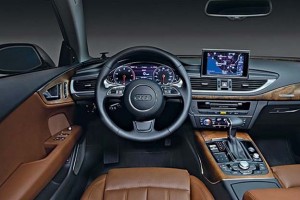More and more, your car has a lot in common with your desktop computer or iPad – which is just great with the folks in Silicon Valley — and with Audi, which drove home with an award for having the top Infotainment Solution used by an automaker at the annual Telematics Detroit Conference.
The maker had some significant help developing the Audi Connect system, but not from the traditional line-up of automotive suppliers. Audi, which operates its own electronic research lab in near San Francisco, turned to the Silicon Valley firm NVIDIA, which is noted for producing high-end computer graphic systems used on everything from aircraft to video games.
NVIDIA produced the processor used to power the A6’s impressive navigation system which is capable of displaying Google maps in real-time.
In the last year, NVIDIA-powered in-vehicle technology has garnered numerous awards. The Audi A8 won the 2011 Technology Breakthrough Award from Edmunds, and the 2012 Connected Car of the Year Award from Connected World, while the Audi A7 won the 2012 Automobile of the Year Award by Automobile Magazine.
More automakers are now looking at NVIDIA to supply the technology for not only navigation and infotainment systems but also for safety systems such as lane departure warnings and pedestrian detection.
“We’re just going to see so much more software going into the areas,” said Daniel Shapiro, NVIDIA’s director of automotive market. It behooves carmakers to come to market with the best equipment and operating system available, which is what NVIDIA can deliver on a single chip, he added.
Manufacturers are now looking for robust processors that can manage the new software as it comes into the automobile, he said. Product planners in the auto industry are specifying that they need to have the best equipment chips and processors available, Shapiro said. In addition, efficient processors can help with weight and packaging, which are perennial problems for car designers.
Manufacturers also are now aware the top two-dimensional and three-dimensional graphics from NVIDIA also are way to reach younger consumers, who are familiar with the technology from gaming and smart phones.
Thus, interest in the technology NVIDIA can offer is growing quickly in the auto industry.
Earlier this year at Consumer Electronics Show in Las Vegas, Audi and NVIDIA announced that the Silicon Valley firm’s Tegra 3 Processor will power in-vehicle infotainment systems and digital instrument clusters across the automaker’s full line starting in 2013. The Tegra 3 processor is a complete system-on-a-chip that incorporates a quad-core ARM CPU, an NVIDIA GeForce GPU and dedicated audio, video and image processors from NVIDIA.
With its energy efficient, integrated design, it enables ultra-fast application processing and vibrant 3D graphics, while placing lower demands on vehicles’ electrical systems.
The new Tesla Model-S will use graphics powered by NVIDIA technology when it is launches later this month, and BMW also has signed on to use NVIDIA’s technology and American and Japanese carmakers are also keenly interested in the high-end graphics NVIDIA’s technology can bring to motorists.
Shapiro notes Silicon Valley has been of two minds about the automobile business. On the one hand it doesn’t offer the same kind of volume that comes with selling 100 million PCs or one billion mobile phones every year — but on the other it offers many of the same sophisticated technical challenges found in defense and aerospace work that has fed the tech industry research and development.
So, there’s no question the Silicon Valley and the auto industry are coming closer together now, Shapiro said. “That’s why you see all these car companies opening up research centers” on the West Coast, he said.

